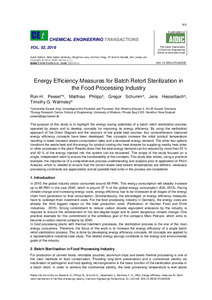Datum
2016Metadata
Zur Langanzeige
Aufsatz

Energy Efficiency Measures for Batch Retort Sterilization in the Food Processing Industry
Zusammenfassung
The purpose of this study is to highlight the energy saving potentials of a batch retort sterilization process operated by steam and to develop concepts for improving its energy efficiency. By using the methodical approach of the Onion Diagram and the recovery of low grade heat sources, four comprehensive improved energy efficiency concepts have been developed. Two concepts increase the initial product temperature resulting in lower transient steam consumption rates and a decreased energy demand. The other two options transform the waste heat and the energy for product cooling into heat streams for supplying nearby heat sinks or other processes in the plant. Results show that the total energy demand can be reduced by more than 23 % and 42 % of the energy injected into the system can be recovered. The scope of the study focused on a single, independent retort to ensure the transferability of the concepts. This study also shows, using a practical example, the importance of a comprehensive process understanding and analysis prior to application of Pinch Analysis, which is needed to ensure that the correct waste heat stream temperatures are defined, necessary processing constraints are appreciated, and all possible heat sinks in the process are considered.
Zitierform
In: Chemical engineering transactions (CEt) Volume 52 (2016) , S. 163-168 ; EISSN 2283-9216Zitieren
@article{doi:10.17170/kobra-202012092468,
author={Peesel, Ron-Hendrik and Philipp, Matthias and Schumm, Gregor and Hesselbach, Jens and Walmsley, Timothy Gordon},
title={Energy Efficiency Measures for Batch Retort Sterilization in the Food Processing Industry},
journal={Chemical engineering transactions (CEt)},
year={2016}
}
0500 Oax
0501 Text $btxt$2rdacontent
0502 Computermedien $bc$2rdacarrier
1100 2016$n2016
1500 1/eng
2050 ##0##http://hdl.handle.net/123456789/12210
3000 Peesel, Ron-Hendrik
3010 Philipp, Matthias
3010 Schumm, Gregor
3010 Hesselbach, Jens
3010 Walmsley, Timothy Gordon
4000 Energy Efficiency Measures for Batch Retort Sterilization in the Food Processing Industry / Peesel, Ron-Hendrik
4030
4060 Online-Ressource
4085 ##0##=u http://nbn-resolving.de/http://hdl.handle.net/123456789/12210=x R
4204 \$dAufsatz
4170
5550 {{Energieeinsparung}}
5550 {{Dampfsterilisation}}
5550 {{Lebensmittelverarbeitung}}
7136 ##0##http://hdl.handle.net/123456789/12210
<resource xsi:schemaLocation="http://datacite.org/schema/kernel-2.2 http://schema.datacite.org/meta/kernel-2.2/metadata.xsd"> 2020-12-15T17:39:25Z 2020-12-15T17:39:25Z 2016 doi:10.17170/kobra-202012092468 http://hdl.handle.net/123456789/12210 eng Urheberrechtlich geschützt https://rightsstatements.org/page/InC/1.0/ 620 Energy Efficiency Measures for Batch Retort Sterilization in the Food Processing Industry Aufsatz The purpose of this study is to highlight the energy saving potentials of a batch retort sterilization process operated by steam and to develop concepts for improving its energy efficiency. By using the methodical approach of the Onion Diagram and the recovery of low grade heat sources, four comprehensive improved energy efficiency concepts have been developed. Two concepts increase the initial product temperature resulting in lower transient steam consumption rates and a decreased energy demand. The other two options transform the waste heat and the energy for product cooling into heat streams for supplying nearby heat sinks or other processes in the plant. Results show that the total energy demand can be reduced by more than 23 % and 42 % of the energy injected into the system can be recovered. The scope of the study focused on a single, independent retort to ensure the transferability of the concepts. This study also shows, using a practical example, the importance of a comprehensive process understanding and analysis prior to application of Pinch Analysis, which is needed to ensure that the correct waste heat stream temperatures are defined, necessary processing constraints are appreciated, and all possible heat sinks in the process are considered. open access Peesel, Ron-Hendrik Philipp, Matthias Schumm, Gregor Hesselbach, Jens Walmsley, Timothy Gordon doi:10.3303/CET1652028 Energieeinsparung Dampfsterilisation Lebensmittelverarbeitung publishedVersion EISSN 2283-9216 Chemical engineering transactions (CEt) 163-168 Volume 52 false </resource>
Die folgenden Lizenzbestimmungen sind mit dieser Ressource verbunden:
Urheberrechtlich geschützt

